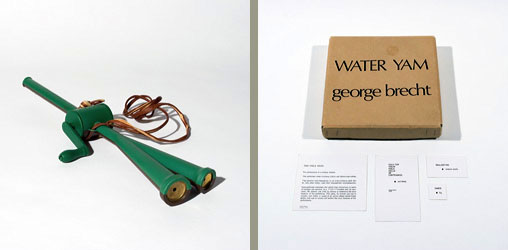The University of British Columbia
21 de octubre al 12 de noviembre de 2006
This exhibition provides a unique opportunity for the Morris and Helen Belkin Art Gallery and the gallery’s Archives to spotlight its growing collection of Fluxus artworks, ephemera and archival materials with a particular focus on those artists for whom John Cage’s ideas and musical innovations acted as a catalyst and symbiotic influence.
Fluxus artists explored the use of chance operations in events and performances, which led to the interactive event procedures that epitomized the Fluxus movement in New York in the 1960s. George Brecht, in particular, embraced the event as a means to investigate the artistic, musical and theatrical possibilities of random factors and chance. His work, Water Yam, consists of a box of event cards, with each card offering directions for an activity or situation to be enacted by the reader. The ambiguity of the instructions allowed for a variety of possibilities in how the event card could be performed.
The influence of Cage’s teachings and innovative approach to composition also resonated abroad with those that came to be included in a growing international Fluxus movement. Like Cage, Zaj Group artist Walter Marchetti was interested in non-traditional composition, and how music could be experiential. In Twenty Solos from “The Hunt” Marchetti presents a collection of bird whistles accompanied with instructions for correctly calling the corresponding variety of bird.
An excerpt from John Cage’s Sculptures Musicales (1989) will be performed during the opening reception by Giorgio Magnanensi and Chris Rolfe. A longer version of this piece will be presented during a special evening performance, Thursday, November 2 at 7:30 pm. Admission is free.
The score for Cage’s piece reads:
Sculptures Musicales “Sounds lasting and leaving from different points and forming a sounding sculpture which lasts” (Marcel Duchamp) An exhibition of several, one at a time, beginning and ending “hard edge” with respect to the surrounding “silence”, each sculpture within the same space the audience is. From one sculpture to the next, no repetition, no variation. For each a minimum of three constant sounds each in a single envelope. No limit to their number. Any lengths of lasting. Any lengths of non-formation. Acoustic and/or electronic. —John Cage 1989





Leave a Reply
Lo siento, debes estar conectado para publicar un comentario.